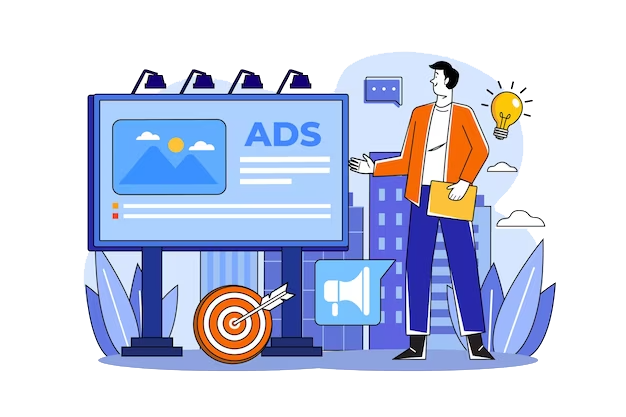Pay per click
Power up your online presence with the precision of PPC advertising!

AN INVESTMENT IS THE BEST RETURN!
PPC can be an effective way to reach targeted audiences, generate leads and sales, and get measurable results quickly and cost-effectively.
Targeted Advertising
Measurable Results
Cost Control
Immediate Results
Monitoring and optimization
PPC stands for Pay Per Click, which is a type of online advertising model where advertisers pay each time someone clicks on one of their ads. PPC ads are typically displayed on search engine results pages (SERPs), social media platforms, or other websites, and they can be targeted to specific audiences based on demographics, interests, and other factors.
PPC campaigns can be an effective way to drive traffic and generate leads or sales for businesses. They offer a high degree of control over ad targeting and budget allocation, and they can be optimized to maximize ROI. However, PPC can be a complex and competitive landscape, requiring careful research, planning, and execution to achieve success.
If you are new to PPC and have never run a campaign before then don’t worry. Your Dream Tech will provide Keyword research, traffic and budget estimates and proposals, to create campaigns with a granular ad group structure.
Exceed Your Target by 40% to 60% with PPC Ads , Your Dream Tech Justify Your ROI.
PPC Advertising Services

Search Ads
Search ads are a type of online advertising that appear on search engine results pages (SERPs) when users search for specific keywords or phrases. These ads typically appear at the top or bottom of the search results, and are marked as "sponsored" or "ad" to indicate that they are paid advertisements.
In Search ads, advertisers bid on specific keywords or phrases in order to have their ads shown to users searching for those terms. Advertisers only pay when a user clicks on their ad, rather than when it is shown.
Search ads are popular with businesses because they allow them to target users who are actively searching for their products or services, making them more likely to convert into customers. They also offer a high degree of control over ad targeting and budget allocation, and can be optimized to maximize ROI.
Display Ads
Display ads are a type of online advertising that appear on websites, social media platforms, and mobile apps in the form of banner ads, pop-ups, and other visual formats. These ads are designed to capture users' attention and promote a product, service, or brand.
Display ads are typically targeted to specific audiences based on demographics, interests, and behaviors. Advertisers can choose which websites or apps they want their ads to appear on, and can also use retargeting to show ads to users who have previously interacted with their website or other digital assets.
Display ads can be effective for building brand awareness, driving traffic to a website, and generating leads or sales. However, they can also be more challenging to create and optimize compared to search ads, as they need to be visually engaging and stand out from other content on the page.


Retargeting Ads
Retargeting ads allows businesses to target users who have previously interacted with their website or other digital assets. When a user visits a website, a retargeting pixel is placed on their browser, which allows the business to track their activity and show them ads across the Google Display Network.
Retargeting ads are effective because they target users who have already shown an interest in a business's products or services, making them more likely to convert into customers. They can also be used to re-engage users who have abandoned a shopping cart or taken other actions on the website but not completed a purchase.
Retargeting ads can be highly effective when done correctly, but it's important to ensure that the ads are not too repetitive or intrusive, and that they provide value to the user. Ongoing monitoring and optimization is also important to ensure that the campaigns are performing well and generating a positive return on investment.
Product Listing Ads
Product Listing Ads allows businesses to advertise their products on the Google Shopping platform. These ads appear at the top of Google search results and feature a product image, title, price, and other information, making it easy for users to compare products and prices.
PLA ads are highly effective for driving traffic and sales to ecommerce websites, as they allow users to see product information and pricing before clicking through to the website. They can also be highly targeted based on factors such as location, device, and user behavior.
Your Dream Tech can help you to set up PLA campaigns to target specific audiences, such as users who have previously interacted with their website or users who have searched for specific keywords related to their products. They can also use bidding strategies to optimize their campaigns for maximum return on investment.


Mobile Ads
Mobile ads refer to the ads that appear on mobile devices such as smartphones and tablets. These ads can appear in a variety of formats, including search ads, display ads, app ads, and video ads.
Mobile ads are an important part of any online advertising strategy, as more and more users are accessing the internet and searching for products and services on their mobile devices. They can be highly effective for reaching users who are on-the-go and looking for information or solutions in real-time.
Mobile ads can also be targeted based on a variety of factors, including location, device type, and user behavior. For example, businesses can use location targeting to show ads to users who are near their physical location, or use device targeting to show ads only on specific types of devices.
GSP ads
GSP ads, or Gmail Sponsored Promotions, allows businesses to show targeted ads in Gmail inboxes. These ads appear at the top of the promotions tab in Gmail, and they can include images, videos, and other interactive elements.
GSP ads are effective for reaching users who are actively checking their email and may be interested in relevant products or services. They can be targeted based on a variety of factors, including keywords, demographics, and user behavior.
One advantage of GSP ads is that they can be highly personalized and relevant to the user, as they are based on the user's email activity and interests. They can also be an effective way to drive engagement and conversions, as users can interact with the ad without leaving their inbox.
However, it's important to ensure that GSP ad campaigns are regularly monitored and optimized, as they can be more expensive than other types of Google Ads campaigns. It's also important to ensure that the ads are not too intrusive or irrelevant to the user, as this can lead to a negative user experience.


Social Ads
Social ads are a type of online advertising that appear on social media platforms, such as Facebook, Instagram, Twitter, LinkedIn, and YouTube. Social ads can take many forms, including image or video ads, carousel ads, sponsored posts, and influencer collaborations.
Social media platforms offer a highly targeted advertising environment, as users voluntarily provide detailed demographic and behavioral data through their profile information and activity. This allows businesses to target specific audiences based on factors such as age, gender, location, interests, and behaviors.
Social ads can be highly effective for building brand awareness, driving website traffic, and generating leads and sales. They can also be an effective way to engage with customers and build relationships through social media.
FAQ
We Have a Lot in Our Fold to Offer. Want to Discover?

PPC, or pay-per-click, is an online advertising model in which advertisers pay each time a user clicks on one of their ads. PPC campaigns can be run on search engines, social media platforms, or other websites, and they allow advertisers to target specific audiences and track the effectiveness of their ads.
PPC works by bidding on keywords or targeting specific audiences, and creating ads that will be shown to those users. When a user clicks on an ad, the advertiser is charged a certain amount, usually based on the bid price for that keyword or audience.
PPC advertising offers a number of benefits, including the ability to target specific audiences, track the effectiveness of campaigns, and control ad spend. PPC can also be highly effective for driving website traffic, generating leads, and increasing sales.
To create a PPC campaign, you’ll need to choose a platform, set a budget, select keywords or audiences to target, create ads, and set up tracking and analytics. It’s important to have a clear strategy and goals in place before starting a PPC campaign.
There are a number of metrics that can be used to measure the success of a PPC campaign, including click-through rates, conversion rates, cost per click, and return on ad spend. It’s important to regularly monitor and optimize campaigns to ensure maximum ROI.
The cost of PPC advertising varies depending on the platform, the competitiveness of the keywords or audience, and the budget set by the advertiser. Advertisers can set a maximum bid price or budget to control costs and ensure that they stay within their budget.
Some common mistakes to avoid in PPC advertising include targeting the wrong audience, bidding too high or too low, using irrelevant keywords or ad copy, and failing to regularly monitor and optimize campaigns. It’s important to have a clear strategy and goals in place, and to continually analyze and optimize campaigns for maximum results.

